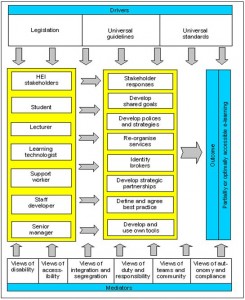Professor Jane Seale of the University of Exeter gave a fascinating keynote presentation at the recently concluded CELebrate 2016 at Bournemouth University. Her address centred on the theme Technology as a tool for inclusion: use and abuse in ‘classroom’ settings. The presentation drew on a conceptual framework build on Practice; Voice and Digital Inclusion to depict that Practice is multidimensional, focusing on accessibility of online material and is influenced by a whole range of factors and involved a range of stakeholders.
There are a number of stakeholders who have a stake in the ‘practice’ and the nature of the practice they develop will be influenced by a range of drivers and mediators as illustrated by the figure below:

A number of factors will influence or mediate practice, in particular stakeholder views of disability; accessibility; integration (inclusion) & segregation; teams and communities; autonomy and compliance. The following are a couple of examples of influences on our institutional practices:
- Out of fear that hearing impaired students will use DDA to complain if they cannot access auditory materials provided in online learning resources, an institution removes all speakers and headphones from all publicly networked PCs, assumes that all students are now equally disadvantaged and that this is OK. As a matter of fact, it is not OK – it marginalises further.
- Another example of marginalisation of the disabled is privileging tradition- the old ways of doings things. Here, assessment is the biggest battle ground regarding disability and inclusion. There have been raging debates over the fairness of allowing disabled students to use laptops in timed examinations because it is perceived to disadvantage non-disabled students as well as perverse misunderstanding of equality. Equality the state of being equal, especially in status, rights, or opportunities- does not mean being treated the ‘same’.
What therefore is best practice?
There is very little literature where university practitioners conceptualise, describe, evaluate or discuss their ‘accessibility’ (digital inclusion) practices and what might constitute ‘best practice’ (Seale, 2014). One element of best practice should be giving disabled students a voice- facilitating their participation as a practice stakeholder. Empowerment and transformation can emanate from dialogue and participation (Freire, Fielding etc.), evident by:
- listening to and valuing the views that students express regarding their learning experiences;
- communicating student views to people who are in a position to influence change;
- treating students as equal partners in the evaluation of teaching and learning,
- thus empowering them to take a more active role in shaping or changing their education
The complexities of digital inclusion practice include:
- Access (to technology and related services);
- Use (that is being able to use technologies or making ‘smart’ or meaningful use of technologies);
- Empowerment (exerting control and choice over use of technologies) and
- Participation (having an influence in the way technologies are used, not passive consumers of disability support services).
The following projects present what we can learn from students that might inform our digital inclusion practices:
The LEXDIS Project
- JISC funded: Learner Experience Phase II (2007/8)
- Produce 30 case studies describing disabled learners’ different e-learning experiences
- Explore and describe how disabled learners experience and participate in technology-rich environments
- Investigate the strategies, beliefs and intentions of disabled learners who are effective in learning in technology-rich environments and identity factors that enable or inhibit effective e-learning
TEDS: Technology Experiences of Disabled Students
- To replicate (in part) JISC funded LEXDIS study conducted at Southampton University in 2008 (Seale et al. 2010)
- Students studying at Plymouth university including partner colleges – 10,000 students studying off-campus (one third)
- Online questionnaire survey- using Survey Monkey- of 175 disabled students: Nov-Dec 2012
- Follow-up semi-structured interviews (f2f, phone) with 22 disabled students (7 off-campus students): Jan-May 2013
The following key findings from the projects awaken the need to foster a framework of inclusive practice:
- We work in ‘splendid isolation’
- We reinforce stigma by denying access
- We wrongly view disabled students with a deficit lens
- We perpetuate rather than challenge exclusion
- We are too rigid in our thinking
- We just don’t think about the impact of our pedagogy
- We Ignore the complex relationship that disabled students have with their technologies and their universities
Digital inclusion practice needs to be transformative and involve the whole of an institution. Universities should transform their structures and processes to ensure that disabled students are able to participate in higher education. This transformation requires three key actions:
- Using technology in all college and university administrative and teaching processes as a tool to increase both the accessibility of higher education to disabled students and the equity of learning opportunities and outcomes;
- Enabling disabled students to make informed and empowered decisions about how to use technology to support their learning in ways that are personally meaningful;
- Ensuring disabled students have ready access to the resources they require to act on these decisions.
We are capable, in partnership with disabled students, of developing inclusive practice!
The Panopto video of the keynote presentation can be accessed here.







